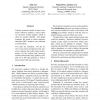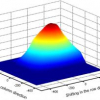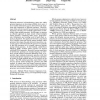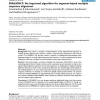609 search results - page 25 / 122 » Better Alignments = Better Translations |
NAACL
2007
13 years 10 months ago
2007
Training statistical models to detect nonnative sentences requires a large corpus of non-native writing samples, which is often not readily available. This paper examines the exte...
ICPR
2006
IEEE
14 years 9 months ago
2006
IEEE
A new approach to align an image of a textured object with a given prototype is proposed. Visual appearance of the images, after equalizing their signals, is modeled with a Markov...
BIBE
2005
IEEE
14 years 2 months ago
2005
IEEE
We propose a method for finding seeds for the local alignment of two nucleotide sequences. Our method uses randomized algorithms to find approximate seeds. We present a dynamic ...
APBC
2004
13 years 10 months ago
2004
Following advances in biotechnology, many new whole genome sequences are becoming available every year. A lot of useful information can be derived from the alignment and compariso...
BMCBI
2005
13 years 8 months ago
2005
Background: We present a complete re-implementation of the segment-based approach to multiple protein alignment that contains a number of improvements compared to the previous ver...




